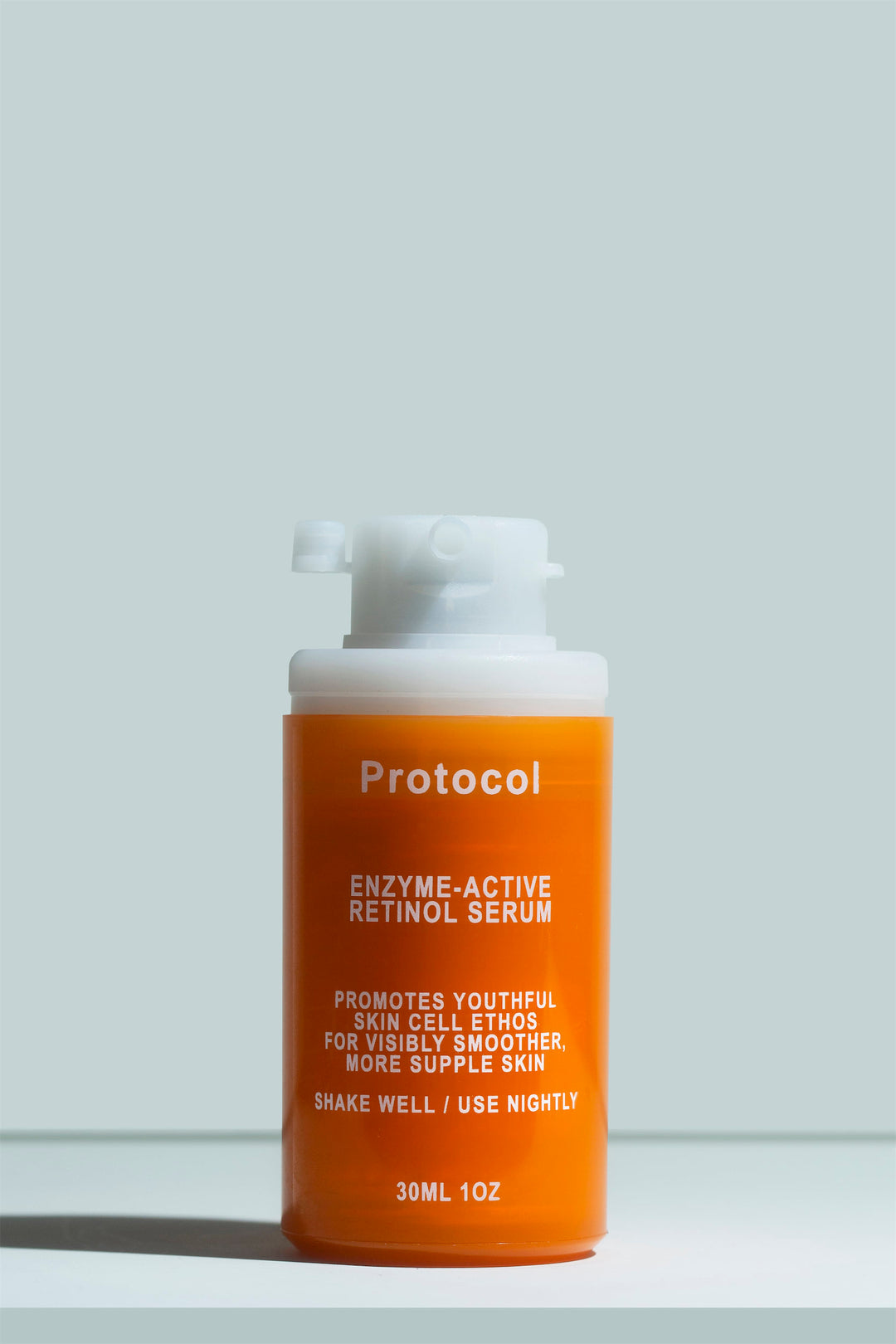The Best Retinol for Sensitive Skin

If you have sensitive skin, you might feel like you can’t use a lot of the active ingredients that everyone else seems to get so excited about. Retinol is probably at the top of the list… But what if we told you that you can use retinol for sensitive skin, and avoid irritation?
In this guide, we’ll cover everything you need to know about using retinol for sensitive skin, including how to find the best retinol for sensitive skin, how to introduce it into your routine safely, and more.
Is retinol safe for sensitive skin?
Retinol can be a safe option for those with sensitive skin, as long as you choose the right retinol and introduce it into your routine safely.
In fact, with its ability to encourage healthier cell turnover, boost skin thickness, and reduce trans-epidermal water loss, retinol can be very beneficial for sensitive skin. It has an unsurpassed ability to create smoother, more even-toned, and youthful-looking skin.
However, retinol and other types of retinoids (i.e., all of the ingredients related to vitamin A) are also associated with an initial period of irritation that dermatologists call retinization.
This doesn’t happen to everyone who starts using retinoids, and it’s also more likely to occur with very strong retinoids like prescription retinoic acid. Then again, those with sensitive skin are more likely to experience retinization.
In the past, dermatologists used to recommend that those with non-reactive skin should just power through that initial period. However, when you have sensitive skin or conditions like rosacea, any irritation or barrier damage can be very hard to tolerate.
The good news is that it’s possible to introduce retinol for sensitive skin, even as a beginner, without irritation.
The best retinol for sensitive skin
The best retinol for sensitive skin will be a product that causes minimal to no redness or stinging, while still transforming your skin on the molecular level. That’s exactly what we created with the Protocol Lab Enzyme-Active Retinol Serum.
These are the key factors that make it such a solid retinol for sensitive skin:
Airtight and stable: As skincare formulas degrade, the compounds in them transform and the overall product can become a little more irritating while also losing its beneficial skin impact. There aren’t many retinoids out there that come in truly airless containers, but formulas that do could be more effective with a lower risk of irritation.
At Protocol Lab, our Retinol Serum manufacturing process and packaging are based on space containment technology, to ensure that our retinol is 100% protected from UV and oxygen. This way, we can ensure our serums won’t break down in a way that can irritate the skin.
Bolstered by soothing agents: The best retinol for sensitive skin also needs to include ingredients that maintain the skin barrier and prevent irritation.
First, our serum contains cyclodextrin. This underrated skincare ingredient is bonded to the retinol, boosting its stability. It has also been found to help mediate retinol’s potential for skin irritation.
Next, we fortified our formula with niacinamide, which is key to preventing barrier damage. If you’re not familiar, one of the most exciting niacinamide benefits for the skin is its ability to boost natural barrier defenses.
Finally, we added a few important skin-soothing ingredients like chamomile-derived bisabolol and aloe vera.
Retinal > retinol: Cosmetic, over-the-counter retinoids come in a few forms with varying levels of efficacy. The impact of a retinoid on the skin is based on how many conversions it must go through once applied to the skin.
The standard logic is that the more conversions, the gentler a retinoid will be. This isn’t fundamentally true, though.
In our Enzyme-Active Retinol Serum, we used retinaldehyde (a.k.a. retinal with an a), which only goes through one conversion to become retinoic acid. This makes it nearly 20 times more impactful than retinol, but amazingly, it isn’t associated with more irritation.
What makes retinaldehyde so unique is that it only converts into the precise amount of retinoic acid that the skin’s receptors can use. In other words, the skin isn’t overwhelmed by a very potent active, but it’s still able to draw maximum benefits.
How to use retinol for sensitive skin
Even those with non-sensitive skin should be cautious in how they use retinol, so our general advice still applies. That said, we’d like to highlight the following suggestions for minimizing your risk of irritation while helping your skin thrive.
Make sure your routine is at a good starting point
If you don’t have a skincare routine in place, it’d be good to build one before introducing retinoids.
That doesn’t mean that you need a complex routine, though. Make sure you have a sunscreen you love for the daytime, a gentle cleanser that doesn’t leave your skin tight or irritated for evenings, and a skin-fortifying moisturizer that can help boost your skin barrier in the lead-up to introducing a retinoid.
It’s okay to have a more advanced routine, but those are the basics. What’s key is that your routine keeps your skin nurtured. Your skin should be at a point where it isn’t showing active signs of inflammation like stinging or redness, and you feel like any flare-ups are rare.
Introduce it slowly
One of the best ways to prevent your risk of initial irritation with any new ingredient is by not using it too often at first. At the same time, you need to use it enough so that your skin can acclimate to it. We think that for most people with sensitive skin, using retinol 2 to 3 times a week at first is ideal.
Then, you can slowly start using it more often until you work up to your maximum usage, which would probably be everyday or every other day.
Buffering and sandwiching
Buffering is a wonderful concept in skincare, especially if you’re using a very strong retinoid like prescription retinoic acid. Buffering means applying strong or potentially irritating ingredients on top of a thicker serum or moisturizer to slow their penetration rate into the skin. While this likely reduces the impact that a product has on the skin, it also reduces your risk of irritation. For those with sensitive skin, this can be a worthwhile trade-off.
Related to “buffering” is the concept of “sandwiching,” which refers to applying your retinol between two layers of moisturizer. This method works especially well for those with dry, sensitive skin!
Note: Most of our clients wouldn’t need to resort to such measures with the Double Enzyme Retinol Serum.
Combine it with soothing ingredients
Whether you’re buffering your retinoids or not, another great way to prevent flare-ups is to opt for soothing products in the rest of your routine. You can benefit from these ingredients in your moisturizer or cleanser, and they can also come from other products like serums and non-astringent toners.
Some ingredients we suggest combining with retinol for sensitive skin:
- Niacinamide
- Centella asiatica
- Naringenin and naringin
- Fatty acids
- Oatmeal extract
- Any high-quality, comprehensive moisturizing ingredients.
What percentage of retinol is best for sensitive skin?
Retinoids come in various strengths, based on the type of retinoid and the percentage of it in the formula. Finding the right percentage of retinol for sensitive skin, especially if you’re a beginner, is a little more complex than just starting with the lowest number.
Retinol is usually used in formulations at percentages between 0.3% and 1%, retinaldehyde at 0.05% to 0.1%, and retinoic acid at 0.025% to 0.1%.
You can also find higher percentages of retinol derivatives like retinyl palmitate or retinyl propionate, but they lack the clinical evidence to prove that they do much of anything.
Most sources on the internet recommend you start with a weaker product, like a 0.3% retinol, before moving up to a higher percentage and finally a stronger retinoid. This type of approach might only delay your results, though, compared to choosing a more bioactive retinoid that’s calibrated to sensitive skin.
Plus, the percentage of retinaldehyde doesn’t seem to factor in the risk of irritation, either: In a study comparing 0.05% and 0.1% retinal, both formulas were equally well-tolerated by the participants.
Get Your Results-Guaranteed Retinol for Sensitive Skin
When you have sensitive skin, we know starting new products can be scary. However, if you choose the right retinoid and introduce it into your routine carefully, the skin rejuvenating benefits easily outweigh the risks.
So if we haven’t made it clear yet - we genuinely think the Enzyme Active Retinol Serum is one of the best retinoids for sensitive skin. Why? Because we actually developed it with inflammatory skin conditions (and especially rosacea) in mind.
Every decision, from adding soothing agents to the formula to ensuring an ultra-stable production process came from the desire to make the best retinol for sensitive skin, and that wouldn’t cause issues for beginners or those with conditions like rosacea and eczema.
We want to make your decision to try our retinol for sensitive skin a little easier, which is why we also offer a results guarantee - that’s because the brands making your products should have your skin’s best interests in mind.




